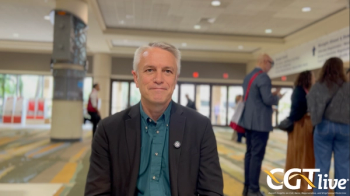
Lete-Cel Exhibits Anti-Tumor Activity, Long Median PFS in Patients With Myxoid/Round Cell Liposarcoma
“Therapy was found to be safe and tolerable. This initial data formed the basis for further exploration that is currently ongoing in the IGNYTE-ESO study,” investigator Sandra P. D’Angelo, MD, tells CGTL.
A single dose of letetresgene autoleucel (lete-cel; GSK3377794) produced good response rates and long median progression-free survival (PFS) in patients with advanced and metastatic myxoid/round cell liposarcoma(MRCLS), according to results from a pilot study (NCT02992743) presented at the
Sandra P. D'Angelo, MD, a medical oncologist at Memorial Sloan Kettering Cancer Center who presented the study, joined CGTL to discuss her ASCO presentation on the preliminary efficacy and safety of lete-cel, an autologous T-cell therapy targeting NY-ESO-1 tumors using a genetically modified, high-affinity T-cell receptor.
“This is one of the first clinical trials exploring the T-cell construct for MRCLS. I think we’ve come to appreciate that a single dose of lete-cel does offer good response rates for those patients that have received higher dose lymphodepletion chemotherapy…Therapy was found to be safe and tolerable,” D’Angelo said.
The open-label study included 2 cohorts: The first (C1) comprised 10 patients who received a reduced-dose of lymphodepletion prior to lete-cel (90 mg/m2 fludarabine [flu] x 3 days + 1800 mg/m2 cyclophosphamide [cy] x 3 days). The 10 patients in the second cohort (C2) received a higher dose lymphodepletion of 120 mg/m2 flu x 4 days + 2700 mg/m2 cy x 3 days.
“The evolution of this trial was based on our prior experience of exploring lete-cel in patients with synovial sarcoma,” D’Angelo explained. “In synovial sarcoma, we know that using this T-cell construct that targets NY-ESO-1 led to remarkable response rates and good progression-free survival. We learned, and were aware actually, that NY-ESO-1 is highly expressed in MRCLS and that led to this current pilot study.”
Check out more of Cell & Gene Therapy Live's
All participants were ≥18 years, with HLA-A*02:01; A*02:05, or A*02:06; advanced or metastatic NY-ESO-1+ MRCLS (≥ 30% of cells 2+/3+ by IHC); prior anthracycline treatment; and measurable disease, according to investigators. The dose range of transduced T cells was 1– 8 × 109. Investigators measured response at weeks 4, 8, 12, 24, then every 3 months until disease progression, death, or withdrawal.
The primary efficacy end point was investigator-assessed (IA) overall response rate (ORR) by RECIST v1.1, with secondary outcomes of safety, independently assessed ORR, time to response (TTR), duration of response (DOR), and PFS.
Investigators enrolled a total of 23 study participants between March 2017 and February 2020. The group was mostly male and all White, with a median age of 47.0 years (range, 33–72). All patients had positive NY-ESO expression. Investigators dosed a total of 20 patients (10 in each cohort) with T cells at a median dose of 4.6 x 109. Median follow-up for C1 was 5.6 months, and 12.9 months for C2.
Forty percent of patients (8 of 20) had 1 prior line of therapy, 30% (6 patients) had 2 lines, and 30% (6 patients) had > 3 lines.
IA ORR measured 20% in C1, with 2 patients displaying best response (BR) of partial response (PR) and 8 patients displaying BR of stable disease (SD). Median TTR, median DOR, and median PFS was 1.9 months, 5.3 months, and 5.3 months, respectively (95% CI: 2.0-11.5).
In C2, IA ORR was 40%, with 4 patients exhibiting BR of PR and 5 patients exhibiting BR of SD. Median TTR, median DOR, and median PFS was 1.9 months, 7.4 months, and 8.7 months, respectively (95% CI: 0.9-NE).
“MRCLS is a disease that is not curable. We have many therapeutic options with chemotherapy that can actually offer a fairly remarkable response rate and good disease control, however, none of these options will…cure our patients so there remains an obvious and important need for new and novel therapies for these patients,” D’Angelo told CGTL.
Investigators observed an acceptable safety profile, with all patients experiencing at least 1 treatment-emergent adverse event (TEAE): 55% experienced a serious TEAE, and 90% of patients experienced grade > 3 treatment-emergent neutropenia (83% probability of resolution of initial grade > 3 occurrence within 30 days).
“One thing we like to focus on in the context of T-cell therapy [is] adverse events of special interest, namely, in the context of this T-cell construct, we did not see any [graft-versus-host disease], or [immune effector cell-associated neurotoxicity syndrome], or [Guillain-Barré syndrome],” D’Angelo said. “There were cases of cytokine release syndrome (CRS). Within both cohorts, nearly all patients did develop CRS, slightly higher in cohort 2…There were more patients also in cohort 2 that actually received tocilizumab and I think that sort of reflects our evolution and appreciation that using tocilizumab is safe and likely does not impact efficacy.”
Investigators are continuing to explore this T-cell construct in future clinical trials, D’Angelo said.
“This initial data formed the basis for further exploration that is currently ongoing in the IGNYTE-ESO study [NCT03967223],” she explained. “Obviously, these are small numbers, [but] we are pleased with and excited about the data and actually look forward to treating more patients to learn more about efficacy end points.”
Reference:
D’Angelo S, Druta M, Van Tine BA, et al. Primary efficacy and safety of letetresgene autoleucel (lete-cel; gsk3377794) pilot study in patients with advanced and metastatic myxoid/round cell liposarcoma (MRCLS). Presented at: 2022 ASCO Annual Meeting; June 3-7, 2022; Chicago, IL. Accessed May 31, 2022.https://meetings.asco.org/2022-asco-annual-meeting/14407?presentation=207994#207994
Newsletter
Stay at the forefront of cutting-edge science with CGT—your direct line to expert insights, breakthrough data, and real-time coverage of the latest advancements in cell and gene therapy.




































